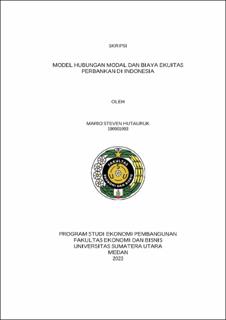Model Hubungan Modal dan Biaya Ekuitas Perbankan di Indonesia
Abstract
This study aims to determine the relationship between capital and the cost of
equity in 40 (forty) go public banks that have been operating from 2018 to 2022
and are listed on the Indonesia Stock Exchange.
This research is a descriptive study that uses secondary data with quantitative
methods. Research data is obtained from annual reports and financial reports
published in the range of 2018 - 2022 by all banks that are the object of research.
Hypothesis testing was carried out using the Partial Significance Test,
Simultaneous Significance Test, and Determination Coefficient Test.
The results of this study indicate that simultaneously, the independent
variables, namely Total Equity, Tier 1 Capital Ratio, Capital Adequacy Ratio along
with other control variables have a significant positive effect on the Cost of Equity,
both based on the Capital Asset Pricing Model (CAPM) and the Risk Premium
Market (RPM) model. Partially, this study also explains that Total Equity has a
significant positive effect on the Cost of Equity of the CAPM model, Tier 1 Capital
has a significant negative effect on the Cost of Equity of the CAPM model, and the
Capital Adequacy Ratio has a significant positive effect on the Cost of Equity of the
CAPM model. As for the RPM model, partially Total Equity has a significant
negative effect on Cost of Equity, Tier 1 Capital has a significant positive effect on
Cost of Equity, and Capital Adequacy Ratio has a significant negative effect on
Cost of Equity. Based on the CAPM model, the coefficient of determination in this
study is 84.63%, and the remaining 15.37% is the influence of other factors not
examined in this study. While in the RPM model, the coefficient of determination is
55.28% and the remaining 44.72% is the influence of other factors outside this
study.
Collections
- Undergraduate Theses [2751]

